Interview sur un site voileux parmi tant d’autres du net (encore 1 qui au début ne pensait pas que du bien de la Class40) :
Questions Net A : Olivier Rabine
Skipper, vidéaste et blogger du Class 40 Ixsea sur la Route du Rhum 2006
lundi 15 janvier 2007 • Christophe Guigueno
Olivier Rabine est de retour de Guadeloupe après une première participation à la Route du Rhum sur le Class 40 Ixsea, un Jumbo 40. Il nous répond à quelques questions à propos de la course, de cette étonnante nouvelle classe de bateaux de 12,18 mètres de long et enfin de ses vidéos embarquées et mises en ligne au quotidien sur son blog pendant la course
1° Quelques semaines après l’arrivée de ton premier Rhum, quel bilan tires-tu de cette première ?
Pour moi c’est un succès, le projet s’est déroulé à merveille depuis avril dernier. J’ai vécu la construction, la mise au point et la course comme un film en accéléré et poser le pied sur La Guadeloupe était l’aboutissement d’un rêve… magique !
Au passage, je gagne ma première course en solo (1040 Milles de st Malo), et pendant le Rhum j’ai toujours été dans le coup, de la 1ère à la 10e place, et je tenais la troisième lorsque j’ai cassé mon pilote. Je suis pleinement satisfait, autant sur l’aspect sportif que médiatique.
2° La Route du Rhum était-elle conforme à l’idée que tu t’en faisais avant le départ ?
Oui et non, au point de vue conditions de course, les Class 40 ont eu une météo très variée avec, en alternance, pétole au près et portant dans la brise, avec seulement 2 jours d’alizé. Pour ce qui est de la difficulté par contre, le Rhum est sans surprise…
3° quel bilan tires-tu aussi de cette grande première course en solitaire en Class 40 ?
Un énorme succès, des bateaux incroyables, un engouement médiatique surprenant.
4° Comment vois-tu l’avenir de la Class 40 ?
Forte de ce succès, l’association de classe a du boulot pour se canaliser, éviter les dérives, monter un programme cohérent, organiser son internationalisation déjà établie. Je pense vraiment que l’avenir est radieux, entre les 6.50, les 40’ et 60’ il y en a vraiment pour tout le monde et toutes les bourses. L’idée a d’ailleurs déjà fait des petits et la venue du 30’ va compléter le tableau de la course au large.
5° Ton sponsor est-il satisfait de cette opération sur la Route du Rhum ?
Oui, c’est clair, l’objectif pour eux était de travailler en communication interne afin de fédérer plusieurs entreprises du groupe autour d’un évènement « FUN », ce qui est réussi. Le résultat va au-delà de leurs attentes puisque nous avons aussi réalisé plusieurs opérations de communication externe.
6° Tu as travaillé sur une communication vidéo ? Comment t’organises-tu à bord pour filmer ?
L’objectif était, dès le départ du projet, de faire vivre la course de l’intérieur. J’étais donc équipé d’une transmission satellite, d’un logiciel de compression d’images et d’une caméra étanche. Je faisais une séquence de 45 secondes tous les jours pour raconter ma course et emmener à bord des centaines de mes collègues par écrans interposés.
Pour filmer, c’est simple, je gardais la caméra à portée de main et dès que j’avais une idée ou un sujet intéressants, je mettais en boîte. Ensuite, lors des vacations, je capturais les images, compression et transmission.
Bon, ce n’est pas aussi rapide que je le pensais, surtout quand le satellite fait des siennes, coupures pendant la transmission, fichiers illisibles….tout n’est pas encore très au point !!
7° Tes vidéos sont désormais accessibles sur un site… Quels avantages tires-tu de cet outil du Web 2.0 ?
Le blog IXFUN.COM a été le principal outil de communication avant, pendant et après la course. On dénombre 360 000 accès en six mois d’existence, provenant d’Europe et des Etats-unis. Les salariés du groupe ont été abreuvés d’info sur la course et ils se sont fait prendre aux jeux…certains se levaient à 4 heures du matin pour regarder ma position et m’envoyaient des messages d’encouragements… avec une équipe comme ça, je n’étais pas tout seul au milieu de l’Atlantique !
mercredi 17 janvier 2007
Interview sur un site voileux parmi tant d’autres du net :
Publié par
vie-project
à
9:37 AM
0
commentaires
![]()
![]()
CHOSE PROMISE, CHOSE DUE
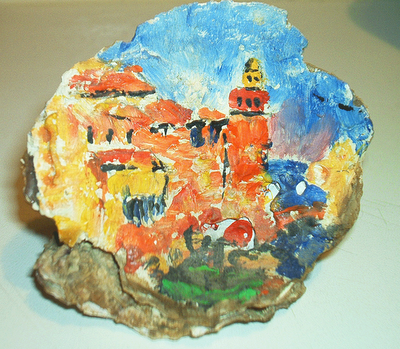
collioure sur huitre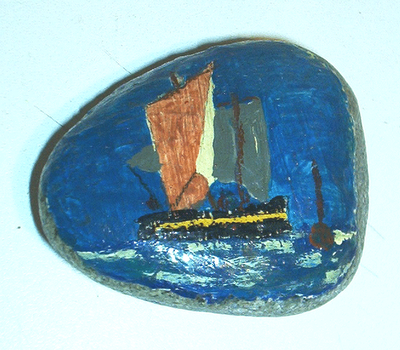
pas très loin de Bréhat, là ou M'sieur Finot va participer à une émission TV vendredi
Publié par
vie-project
à
9:33 AM
0
commentaires
![]()
![]()
LA CLASS 40 UNE NOUVEAUTE ??????????????????
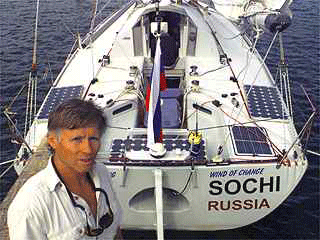
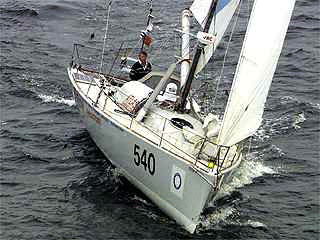

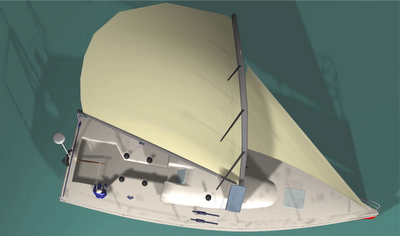
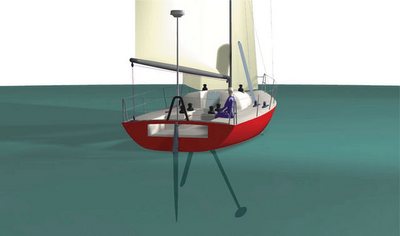
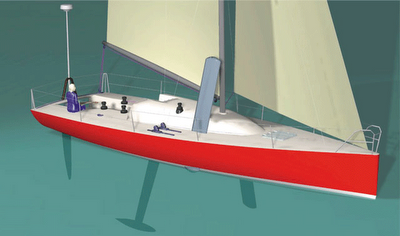
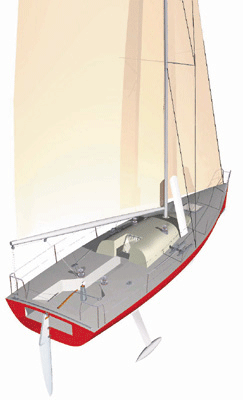
Wind of Change
Open 40 Around Alone Challenger
Viktor Yazykov - skipper
Overall configuration:
Cutter-rigged sloop _LOA: 12.28 m _Overall Beam: 3.90 m _Draft: 3.0 m _Displacement: 3600 kg
Special Features:
. Canting, high aspect ratio keel
. Central water ballast tank
. Single rudder
. Twin dagger boards
. Bowsprit
All Photos by Billy Black
Sail Inventory:
Mainsail: fully battenned, 80 m2 _Genoa: on a Profurl furler, 36 m2 _Staysail: 19 m2 _Storm jib: 6 m2 _Assymetrical spinnaker (with sock): 120 m2 _Symmetrical Spinnaker (with sock) _Masthead Code Zero Genoa: on a Profurl furler, 90 m2
Keel: Canting carbon fiber fin keel with hydraulically-operated canting mechanism. The carbon fin was manufactured by Hall Spars, RI, US. The canting mechanism is manufactured in the USA.
Water ballast tank:located on the centerline for extra punch when going upwind, total displacement - 0.8 tons. The canting keel is used to balance the boat when reaching or running.
Mast: built by Hall Spars, RI, US.
Rudder: designed by Dirk Kremers and built by Viktor Yazykov.
Bowsprit: aluminum, 1.0 m
Rigging: Rod rigging by Navtex
Winches: Anderson 42 , 6 winches
Autopilots:Robertson (needs calibration), Autohelm 4000
Electronics:
. KVH instruments
. KVH GYRO AZIMUTH gyrocompass
. JRC radar, max useful range - 24 miles
. Inmarsat C
. SSB radio Icom
. VHF Icon
Best speed averages in 1998-1999 Around Alone race:
- 289 miles in 24 hrs in the Southern Ocean
- 240 miles in 24 hrs during the solo surgery performed in Leg 1. During this run the boatï¿_s autopilots were not operational and the boat sailed balanced by a bungee cord tied to her tiller.
- 1000 miles in 4 days, twice during the race. The second of these runs was during Leg 4 in trade winds, when the boat's autopilot was not functional.
Update: June, 2000 - Viktor purchased a suit (main & jib) of new Cuben Fibre sails from Shore Sails, Newport, RI. The sails were used only during the Europe 1 New Man Star singlehanded race from Plymouth, England to Newport, RI. The sails weight half the weight of Viktor's old kevlar sails. Here is a photo of the boat with the new sails at the start in Plymouth.
Core sample of the boat's hull sandwich: _ _The hull is balsacore with two layers of very thin chestnut veneer /unidirectional carbon/epoxy, vacuumed everything.
Launch of the boat in Sochi, 1999: _
Update: July, 2001 _The most-current sail inventory on the boat: _-Cuben fiber main 80sq.m. _-Cuben fiber genoa 45 sq.m. _-Spectra code zero 85 sq.m. _-Asym. Spin. 120 sq.m with ATN sock(needs some repair) _-Spectra mainsail 78 sq. m. _-Spectra genoa 42 sq. m. & Inner Jib 25 sq.m. _-Storm jib. _The cuben fibre sails were built in 2000 by Shore Sails, Newport, RI, and were only used for the Europe 1 New Man Star race (see photo above). These sails would make it in the around the world race. All other sails are in good shape.
Wind of Change
A remarkable 40 foot raceboat
by Quentin Warren_Blue Water Sailing
An unlikely challenge from left field adds a new dimension to Around Alone and breathes life into the notion of an Open Class 40 Think word association. Most people - upon hearing "yacht design" and "Around Alone" in the same breath - are apt to rattle off "Groupe Finot" and call it a day. It's only natural. The French Finot brothers have put an indelible mark not only on that event in particular, but also on modern-day competitive solo sailing in general. Currently, they own Class I of Around Alone (Isabelle Autissier's PRB, Marc Thiercelin's SOMEWHERE and Giovanni Soldini's FILA), and they lead Class II (J.P. Moulign?'s Cray Valley and Michael Garside's Magellan Alpha).
But among the more inspiring vessels in the Southern Ocean right now is a diminutive 40-footer derived from the combined vision of two passionate solo sailors - one Russian, the other American - and a British yacht designer living in Newport, RI. It is Wind of Change, breathing down the backs of the three 50s in Class II, successfully halfway around the world, marvelously intact in a race that has taken its toll on a host of fellow competitors, all the while proving that bigger need not necessarily be better.
To be sure, the Wind of Change program was conceived as a two-boat effort, reflecting the duality of the skippers who spearheaded it and the notion that even given their common crusade, individuality remains at the core of singlehanded sailing. As it turned out, two virtually identical vessels were built; one made it to the starting line off Charleston, SC - albeit late - while the other now sits in Jamestown, RI, her circumspect skipper having decided in a qualifying run across the Atlantic last summer that he simply needed more time to sort the boat out.
The Russian is Viktor Yasykov, a former paratrooper born and raised in the small Black Sea village of Sochi. He is keeping the Around Alone Class II group honest right now en route to Cape Horn, his Wind of Change - "a most remarkable boat," as he puts it - picking her way through the Southern Ocean with the tenacity of the Cheshire cat. The American is Bob Adams, a lifelong sailor raised in Connecticut and now living in Jamestown, whose affection for his own Wind of Change is equally as intense as Viktor's, and whose plans for the boat down the road are many, varied, focused and promising, despite the decision to table his entry in this year's Around Alone.
And the designer - or, more appropriately, design consultant, given the formidable input of Yazykov and Adams - is British-born Stephen Baker. Formerly an associate at Rodger Martin's design office and certainly no stranger to the subtleties of competitive solo sailing boats, Baker now draws on his own. Says Adams: "The design process was born of a strong friendship between Viktor and me, of sympathy in values. We needed to centralize our design efforts in the U.S., so we went to Stephen Baker. He was willing to work with the two of us. He wasn't burdened with an ego. He was the glue that held it all together." Engineering support was provided by Dirk Kramers of Rhode Island-based Dirk Kramers & Associates.
The boats were built side by side in Sochi in 1997-98, and launched in June of 1998 as the clock ticked on the September start of Around Alone. As is so often the case in grass- roots campaigns such as this, slowdowns, holdups, funding, time, and the problematic geography of a hands-across-the-sea collaboration wrought havoc with the Wind of Change schedule and put both skippers decidedly behind the eight-ball. Nonetheless, two good boats materialized - "very well designed, very well engineered, and extremely well executed," beams Adams.
Varied Input
In very general terms, it is probably safe to say that Yazykov's predominant contribution design-wise was in the realm of hullform. Adams, a onetime sailmaker, choreographed the rig. "Viktor has a strong sense of the aesthetics of hull design," remarks Bob. "He sees the nuances, intuitively asking himself, ?How light can we make it, what's the best shape, how do we minimize wetted surface, how do we make it an easy hull to drive?' So the basic form of this hull came from Vic. He and Stephen refined their thinking on the design during the winter of 1995."
The hull is very reminiscent of the Finot 50s and 60s, with some significant departures. Like the Finots, the Wind of Change 40 sports plumb ends, a fine entry and flat sections, with max beam carried aft and an extremely shallow canoe underbody. However, 12 feet of beam over 40 feet confers a length/beam ratio of 3.2:1, relatively narrower than the French designs. Similarly, the after end is not quite as flat, nor as extreme, as the late-generation Finots - a product, as Adams calls it, of "Vic's feel for the boat." The presumed intent, a vessel with more optimal windward capability and a relatively more stable ride.
The foils point to further independent thinking. Most noticeably, the nine-foot keel foil with its 2,500-pound ballast bulb lives way aft - under the cockpit and astern of the cabin, no less. Optically, the boat looks totally out of balance. Empirically, however, there is a reason for this configuration, and it has proven itself on the water. "Ever seen a crewed boat going downwind in a breeze with bodies forward of the shrouds?" asks Adams rhetorically. "We wanted to optimize stability and control in hard-running conditions. The weight moved aft." As it turns out, Wind of Change on a mooring sits curiously bow up. Hoist some canvas and put a bone in her teeth and she levels right out. And flies.
The keel swings port and starboard 25 degrees or so to get the weight out to windward on a heel in lieu of water ballast. The system is simple and proven, based on a massive stainless sleeve that pivots around a pin and is controlled hydraulically at the companionway. On the issue of swing keels vs. water ballast, Adams queries, "Why go to all the trouble of building a boat light to make her go fast, then load her up with hundreds of pounds of water ballast just to keep her on her feet?" Good point. In fact, the 40 was designed originally for conventional water ballast, but midway through the project that scenario was rethought.
Hydrodynamic lift is provided by asymmetrical daggerboards port and starboard, each canted 15 degrees. According to Adams, in the proper conditions the leeward dagger literally pulls the boat to windward. Steering is by way of an external transom-hung rudder foil on centerline and a conventional tiller, overseen by an Autohelm 4000.
A Hybrid Rig
As innovative as Yazykov's input on the hull was Adams' contribution to the rig. An inveterate self-proclaimed fiddler, Adams avoided both conventional cutter thinking and the trend popular among the Finots towards low-aspect rigs with long booms in his quest to outfit Wind of Change with a truly purpose-built sailplan designed for the broad range of conditions doled out in Around Alone. The result is what Adams calls a "fractional/masthead" configuration, the cornerstone of which is its versatility. The approach derives from the rig he designed for a J/35 he campaigned in singlehanded events earlier in this decade.
The mast is relatively tall and the mainsail roachy but high-aspect. The foretriangle features a fractional headstay brought to about seven-eighths, a lower inner forestay for staysails and storm canvas, and a masthead sheave for kites and various other light-air or downwind sails. "We tend to think of these races as hard running," explains Adams. "To an extent, of course, they are. But it's the light-air component that figures in the end. You know what they say, ?It's not how fast you can sail, but how long you can sail fast.' You need the horsepower to optimize the boat in light air. You need to be able to make major luff adjustments. With this rig you can, without lugging a massive section around the world."
With swept-back spreaders to stabilize the rig and three-part runners to secure the masthead and hounds, the spar can be tall and lean at the same time. Utilizing the fractional foretriangle upwind and in heavy air, the boat remains more or less under control and avoids becoming dangerously overpowered. Hoisting sail to the masthead in benign conditions increases the boat's potential horsepower dramatically. "The Finot boats have better SA/D numbers than we do upwind," says Adams, "but downwind in light air, we can heap on more relative sail."
Lightness and Strength
Russia is not world-renowned for its boatbuilding, nor is the Black Sea a hotbed of competitive yachting. Nonetheless, the two 40s that sailed from Sochi last summer lived up to design expectations right out of the box - and, of course, Yazykov's continues to now. At a svelte 8,000 pounds each, they hit their displacement parameters spot on. Without any appreciable structural failures to speak of after literally thousands of miles, the two Winds of Change are, well, significant.
The hulls consist of balsa core, surrounded inside and out by two layers of thin chestnut veneer laminated at 45 degrees, then carbon skins. The decks are balsa core simply laminated between carbon skins; the cabin structure is Divinycell and carbon. Interior reinforcement is by way of longitudinal stringers and a rabbit warren of structural bulkheads securely bonded to hull and deck.
The non-dimensional numbers speak for themselves. Upwind SA/D at 49 is atomic; as discussed, the potential for raising this figure in the appropriate conditions given the versatility of the rig is a further performance factor. Displacement/Length tips in at 67. These numbers - combined with a low-wetted canoe underbody that draws barely 12 inches and a dynamic set of directional foils - spell speed and agility.
Wherefore Art Thou
So what does it all mean for the rest of us? Is there a blue water cruiser in there somewhere? Of course not. Wind of Change is of the don't-try-this-at-home school of thought. There is no standing headroom to speak of below, the ballast situation requires constant vigilance, the rig is highly tuned, the cockpit is small and untenable, the boat is a stammering thoroughbred; without your wits about you, you could get hurt on this thing.
But the appearance of these particular two boats is refreshing. Bob Adams remarks that the relative affordability and manageability of the 40s in the context of upper-level shorthanded sailing circles brings events such as Around Alone within reach of unsponsored or thinly-sponsored entrants - this, without relegating those participants to non-competitive Corinthian status in a game that calls increasingly for a state-of-the-art approach.
Mimicking the Wind of Change effort, there are four other Open 40 projects in various stages of design and construction on North American burners as we speak. Says Adams, "I'm hoping I'll be in there for the next Around Alone. I'm certainly in there for the next singlehanded transatlantic race. There is a lot of excitement about this boat out there, about 40-footers in general."
And face it: For plenty of people, it's just no fun to go slow. Neither Bob Adams nor Viktor Yazykov would have it any other way. In a telephone interview with Viktor in Auckland two days before the start of Around Alone Leg 3, the solo sailor was at times poignant about the remarkable vessel he designed and built, a vessel that threatens to carry him all the way around the world on the coattails of the big guys.
"I don't know any boat that can do the same as this," he told BWS. "In previous leg, I have main problem with autopilot. I have to steer. This boat is so easy to steer. Wind of Change steers itself eighty percent of the time. Now that problem is adjusted. I am organized and I go. I have prepared the boat. I have prepared myself. In Leg 3 I don't make goals; I just do the most sensible thing."
The most sensible thing. You take care of the boat, and the boat will take care of you. Even in the big leagues. On a 40 footer.
Publié par
vie-project
à
9:28 AM
0
commentaires
![]()
![]()

